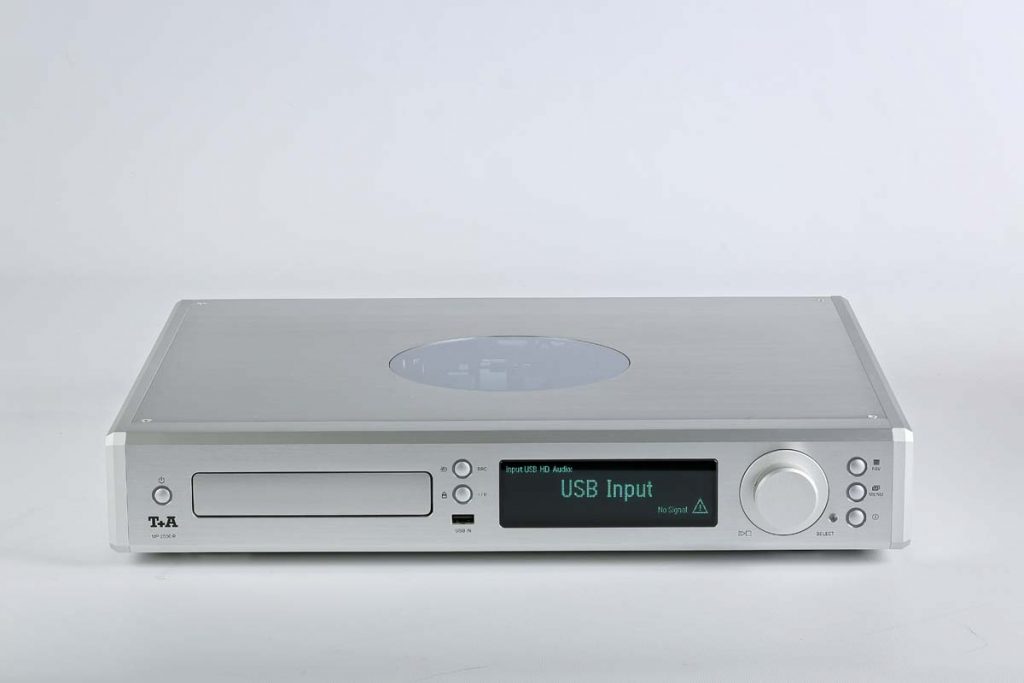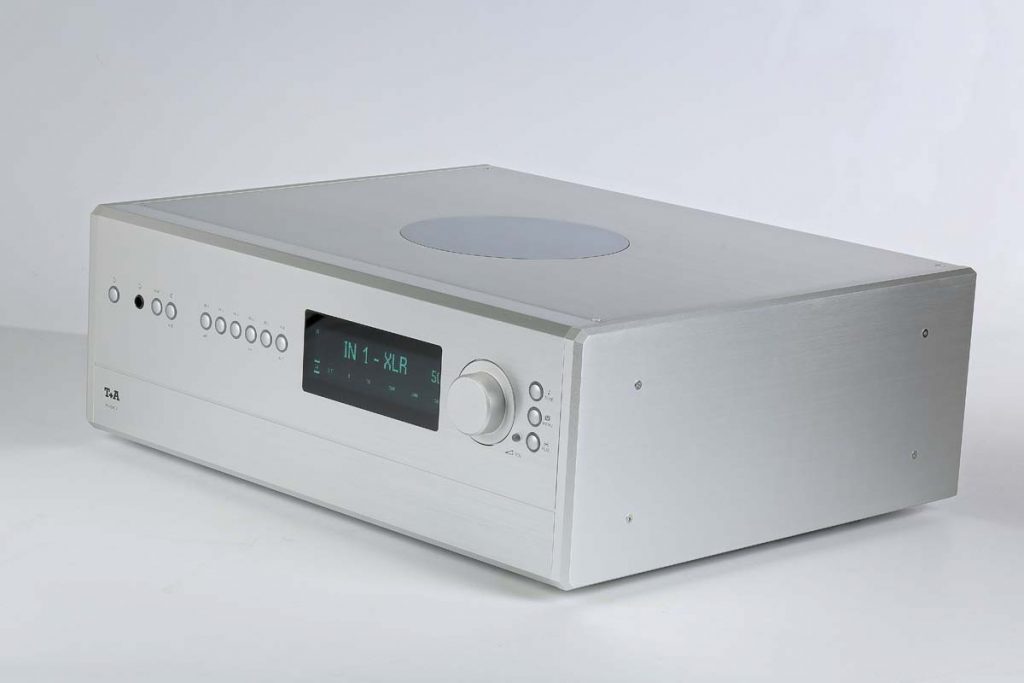Peace at Last
I can already hear the outcry. Peace? What’s he talking about? Music is meant to be exciting! We want stimulation not tranquility! How can this writer praise peace above all else? That’s insane! And yet, that’s exactly what I’m doing.
When you start to think about it rationally, it’s not insane at all, simply a matter of priorities. When my hi-fi enthusiasm first began to take form, equipment from T+A wouldn’t have been my initial choice: too sleek, too perfect, too few options to play around with. In those days, the first thing I did when a new CD player arrived was stabilize the rattling lid with bitumen pads, replace the fuse, and maybe even swap the little cable between the output stage and the jacks. If I heard about some replacement feet that might be better for my equipment, I’d try them out immediately. And sometime later I’d find myself soldering in some of that really fine silver cable.
But I don’t get excited about that sort of thing any more. This is partly due to the fact that most equipment is simply better these days. The other reason is that tinkering around with gear this way — regardless of what you might actually gain from it — gets in the way of the music itself. It’s a distraction. And, of course, there’s the additional possibility that some of this “fine-tuning” might not be completely legal … But if the equipment is more important to you than the music you play with it, we’re obviously not on the same wave length. In this case, maybe you should just move on to the next article.
It’s simple
For a real music lover, the ideal hi-fi system does the following: It attempts to recreate as much detail from the recorded material as possible without adding anything of its own all the while trying to produce the same performance quality for the full gamut of music styles and their different needs. What’s more — and this shouldn’t be underestimated — it simply needs to work! You don’t need to warm it up for hours beforehand; you don’t need to furnish your room around it; you don’t need to spend years looking for cables that will coax out some of those hidden qualities (until, for example, you chance on a suitable adapter for those nonstandard input and output impedances on your chosen piece of equipment). No, none of that. With the ideal hi-fi system, all you need to do is place it in a suitable location, connect everything up, and enjoy the music. It’s simple. For me at least, this is the dream.
This is why I didn’t roll out the red carpet for the PA 2500 R amplifier and the MP 2000 R CD player, both from T+A. At the start of my test, I simply placed them on the floor between the speakers, hooked them up with the first cables I found, switched them on and starting listening. It’s simple. Despite not configuring anything at all, the sound was really good. So good in fact, that I listened for longer than I’d planned. I really wanted to hear the end of Dmitri Shostakovich’s String Quartet No. 8. If that wasn’t a positive sign that things were going well…
Certain devotees
The PA 2500 R integrated amplifier isn’t, of course, the right choice of equipment for newcomers who love to tinker around — the price alone rules it out. The weight is also a bit of a riddle. At 14.5 kilos, it doesn’t seem weighty enough for certain high-end devotees to take seriously — it just isn’t the heavyweight contender they tend to go for. The riposte lies in a very cleverly designed switched-mode power supply. It has a dual mono design that is amply filtered across all stages and delivers 1,200 watts to the outputs. This is more than sufficient for an amplifier that is officially specified to deliver 2 x 280 watts into four ohms. The benefits, however, are threefold: There’s simply no humming or hissing at all. The PA 2500 R also couldn’t care less how demanding the connected speakers are. And, of course, the capacitance of the speaker cable is irrelevant. This already addresses a few points on my list. The lucky owner of the PA 2500 R has a whole range of adjustable parameters at his or her disposal that all deserve an impartial assessment. The tone control, frowned on by many high-enders, can be finely adjusted over a number of menus and sub-menus.
This definitely results in better performance than a directly playing amplifier in a room with really poor acoustics. Using only pretty modest resources (a convenient interface, a measurement microphone, free analyzer software, and pink noise), you can avoid “guesstimates” and correct the worst distortions caused by the room or speaker. For hardliners, of course, this function can be completely bypassed. Apart from this, the PA 2500 R is a deliberately unpretentious unit, with high-quality connectors on the back panel and an Ethernet port that’s exclusively available for communication between devices. There’s no integrated streaming module.
An all-rounder?
But a streaming module is available in the MP 2000 R. Referred to previously in this text as a simple CD player, this component is in actual fact a hi-res DAC with CD drive, streaming module, and DAB tuner — a genuine specimen of the new class of multisource players. Connections to networks or the Internet can be set up using either WLAN or LAN, and mobile devices can also be linked up over Bluetooth. Other digital sources can use a native USB port as well as coax or optical inputs. The dual XLR outputs are a whole lot more than just fancy, high-end decoration: The quadruple PCM 179 converters from Texas Instruments (32 bit/192 kHz) already produce a balanced signal that is further refined by the MP 2000 R. If the signal received at the digital inputs has timing errors, it is completely rebuilt before being passed on to the second stage. Here, it is filtered again to eliminate further jitter before reaching the converters.
In the MP 2000 R, there are four separate digital filters to handle the usual pre- and post-ringing. Filter one has a strict linear frequency response. With only limited capping of pre- and post-ringing, I enjoy the striking performance and the tight bass. Neither filter two, designed to considerably reduce time domain errors, nor filter three, intended to generate an “analog” sound using digital means, are really my thing. Filter four, however, thoroughly eliminates all time domain errors. Thanks to its spaciousness and an atmospheric compactness that’s somewhat hard to describe, this filter became my absolute favorite after a few hours. Connecting up to desired media is simple and fast: attach the unit to the computer using a USB cable, click on the T+A device (should be automatically visible) in the system settings, and get started. I had no problems using any of the players I tested — from iTunes, JRiver, and PureMusic to music directly derived from Magix’s DAW Sequoia. Connecting to the network is equally straightforward. Using a LAN cable, you select the network drive and can immediately surf through your music files. You don’t even need a password (at least I didn’t). Listening to Internet radio is just as easy. It’s simple. A dream to use.
Charm and supremacy
After all this, I finally placed both units on a proper rack. As speakers, I used pairs of Diapason Adamantes 25th, Spendor 3/5 SE, and Harbeth Monitor 30.1. As expected, there were no problems at all with any of these models. The compact Spendors place real demands on other equipment despite their small size. Combined with the T+A amplifier, however, they produced an unusually laid-back sound and showed great control response in spite of their limited sensitivity. Although they can sometimes sound brittle on coolish amplifiers, the Diapasons were supple and refined, too. Connected to the T+A , the Harbeths emit a wonderfully spacious resonance and individual sound events are minimally enlarged and presented in subtly differentiated colors—a superb combination for music lovers!
It seems the PA 2500 R shares much of its DNA with its older HV siblings, playing with the same fluidity and lack of harshness. No matter what type of music was played, the delicate and broad overtone range was particularly appealing, giving every piece an ethereal quality in addition to an uncompromising foundation. In terms of spatial performance, the amplifier found an excellent balance between studio-oriented correctness and playful ambiance, in the process enriching the obligatory objectivity with a spoonful of charm. This hint of extra pep is especially valuable for spicing up drab recordings or CDs from the digital stone age. But I definitely don’t want to give you the impression that T+A has given itself over to euphony: I wouldn’t hesitate a moment to use a PA 2500 R as an amplifier in a mastering studio!
Team player
Regardless of the source used, the MP 2000 R captivates with its tremendous attention to detail and a precision that reveals no trace of harshness — right down to the lowest ranges. For a device of this type, the CD drive is above all astoundingly steadfast in these lower regions. There are few other players that come correspondingly close to a benchmark device like the Mark Levinson 390S. But the T+A also comes with all the other network and USB options and is only half the price. All in all, a real bargain.
My test package was rounded out by the R Series turntable. The G 2000 R will appeal to many T+A customers and I’m not able to give it as much attention here as it deserves. It can be easily assembled, plus it has wonderfully smooth motion and a punchy, precise, and spatially expansive sound. Any extraneous noises made during playback also remain amazingly far in the background. Yes, this turntable really warrants more attention. All the more so, because its integrated high-quality phono pre-amp means it can be connected up to any high-level input. But the other two T+A test units are so richly detailed that I’ve simply run out of space.
So, let’s recap: Could these R Series units from T+A really constitute the ideal system? In my opinion, yes! Producing a sound that puts them close on the heels of their bigger siblings, the PA 2500 R, MP 2000 R, and G 2000 R perform at least on par with the majority of high-end components but without the same degree of neediness. They simply work. And you finally have time for the music!
Complete System
T+A R Series 2000
T+A PA 2500 R integrated amplifier Power output (8/4/2 O): 2 x 140/280/560 W | Dimensions (W/H/D): 46/16.5/41 cm | Weight: 14.5 kg | Price: €7,500
T+A MP 2000 R Mk II multisource player Digital inputs: 2 x coaxial, 2 x TosLink, 3 x USB | Dimensions (W/H/D): 46/8.2/40 cm | Weight: 8 kg | Price: €5,900
T+A PA 2000 R turntable Standard tonearm: Rega | Standard cartridge: Ortofon 2M Bronze | Options: integrated phono equalizer (490 euros), Clearaudio Carbon 2 tonearm with MC2 system (1400 euros) | Dimensions (W/H/D): 46/16/38 cm | Weight: 14 kg | Price: €4,500
Warranty period: three years
T+A Elektroakustik GmbH
Planckstraße 9–11
32052 Herford, Germany
Phone +49 5221 76760
























